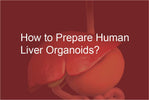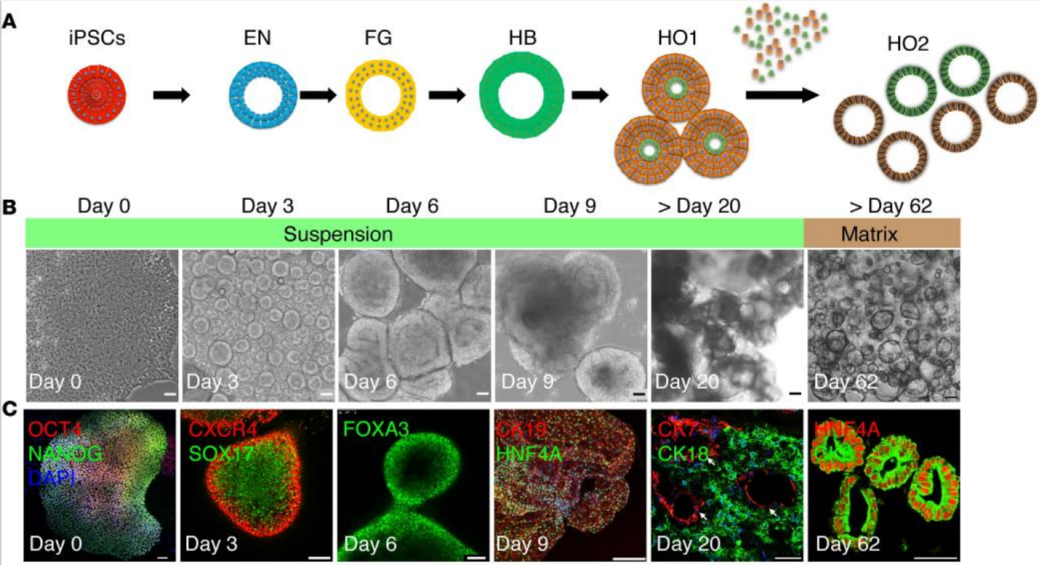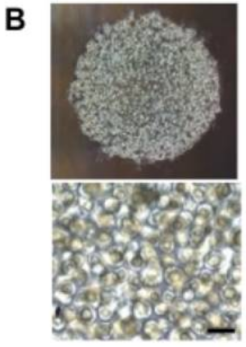How to prepare human liver organoids

The liver is one of the largest organs in the human body, originating from the hepatic bud structure derived from endodermal cells of the foregut epithelium. It primarily serves metabolic functions and plays a role in detoxification. Imbalance in liver function can lead to pathological conditions known as liver failure and may result in hepatitis, fibrosis, cirrhosis, cancer, metabolic, or autoimmune diseases. Therefore, to fully understand the phenotypes of each liver disease and the mechanisms of organ damage, we need in vitro personalized liver model systems for disease modeling, drug discovery, and drug toxicity studies.
Hepatic organoids (HLO, HO) are 3D models of liver function that retain the primary physiological characteristics of liver cells. Organoids can be generated from iPSCs, ESCs, or specific adult cells (such as epithelial cells or epithelial cells and mesenchymal cells) in the presence or absence of a matrix.
Cultivation Protocol for Hepatic Organoids
We have compiled a cultivation protocol for generating hepatic organoids from human induced pluripotent stem cells (human iPSCs) based on three articles published in JCI Insight[1], Cell Metab[2], and J Hepatol[3].

Figure 1. Process of iPSC Differentiation into Hepatic Organoids (PMID: 28878125)[1]
A: Schematic of iPSC Differentiation into Hepatic Organoids; B-C: Morphological and Cellular Marker Changes During Hepatic Organoid Development at Day 0 (iPSCs), Day 3 (Definitive Endoderm, EN), Day 6 (Foregut, FG), Day 9 (Hepatic Progenitors, HB), Day 20 (HO1), and Day 62 (HO2).
Inducing Definitive Endoderm
iPSCs were dissociated into single cells using a buffer containing 5 mM EDTA and 10 mM Y-27632, plated onto low-adhesion 6-well plates, and cultured in RPMI-1640 medium supplemented with Activin A (100 ng/mL) and BMP4 (10 ng/mL) for 3 days.
Inducing Foregut Spheroids
The culture medium was switched to RPMI medium containing 2% Matrigel and B27. From day 3 to day 6, 50 ng/mL FGF10 was added to the medium. From day 6 to day 9, the medium was supplemented with 10 ng/mL FGF10 and 10 ng/mL BMP4.
Inducing Organoids
From day 9 onwards, the culture medium was changed to Hepatic Organoid Growth and Differentiation Medium (HCM) containing 1% Matrigel, 50 ng/mL HGF, 50 ng/mL oncostatin M, and 10 μM Dexamethasone.


Figure 2. Process of iPSC Differentiation into Hepatic Organoids (PMID: 31155493)[2]
A: Schematic of iPSC Differentiation into Hepatic Organoids; B: Bright-field images at Day 0 (iPSCs) and Day 20 (HLO).
Organoid Expansion
On the 20th day, collect the culture, dissociate the cells, centrifuge at 200 g for 3 minutes, collect the cells, resuspend in 50 μL GFR-Matrigel, and seed into a 24-well plate. After Matrigel solidification, add 1 mL growth medium (RPMI-1640, B27, 250 nM LDN-193189, 3 μM CHIR99021, 10 μM A83-01, 100 ng/mL EGF, 10 ng/mL FGF10, and 20 ng/mL HGF) and culture the cells for 6 days. Then, change to differentiation medium (HCM medium, 10 μM DAPT, 10 ng/mL oncostatin M, 20 ng/mL HGF, 10 μM Dexamethasone, and 10 ng/mL BMP4) and culture for another 6 days.
Related Products
|
Product Name |
Catalog Number |
Specifications |
| 3DCultr Liver Cancer Organoid Growth Medium(Human) | C231108 | 50/100/500 mL |
|
Recombinant Human BMP-4 Protein |
C230310 |
10/100/500 μg |
|
Recombinant Human EGF Protein |
C230328 |
100/500 μg |
|
Recombinant Human/Mouse/Rat Activin A Protein |
C230520 |
10/100/500 μg |
|
Recombinant Human FGF-4 Protein |
C230346 |
5/100/500 μg |
|
Recombinant Human FGF-10 Protein, His Tag |
C230418 |
5/100/500 μg |
|
Recombinant Human Hepatocyte Growth Factor (Human HGF) |
C230260 |
10/50/1 mg |
|
Recombinant Human Oncostatin-M/OSM Protein |
C230466 |
10 /100 /500 μg |
